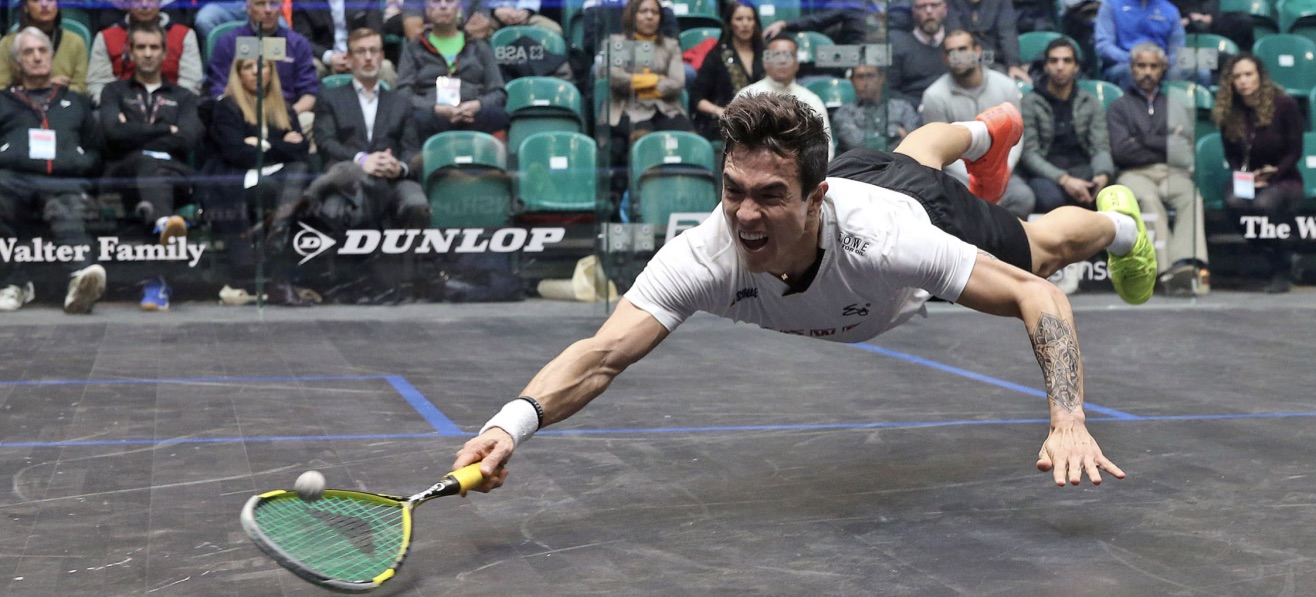
When Miguel Rodriguez dives across court it’s a race against time to get there before the ball bounces twice
Your brain has to master four dimensions before you can master squash
By CHRIS SARGENT – Squash Mad Columnist
Why is squash so addictive if you are that way inclined? This is a question that has puzzled me ever since I started playing around 10 years ago. Why, because having never played a racket sport before, I was instantly addicted and remain so today.
I used to think it was the buzz from the exercise and hard work that had hooked me. Also, the therapy of hitting a small black ball hard and that satisfying “thwack”. But it is much, much more than that.
I have come to the conclusion that it is not the fact that it gives you a great workout. It is not the adrenalin buzz or the one-to-one competition. I have done other sports that easily compete on these terms (karate for example). What is it that keeps me wanting to get back on court?
I have come to a pretty simple conclusion (and a realisation that has helped my own squash). It may just be me, but I have finally realised that squash is played in Four Dimensions. I think this is pretty much unique in individual competitive sport.
What do I mean by four dimensions? Well, you have length, width, height AND time (speed of shot, movement etc).
Think about it, we use all four (some coaches suggest six) corners of the court. We use the full height and space available above the floor level AND we use the speed of shot. We use them combination to manoeuvre our opponents out of position and win points.
When you compare this to tennis, for example, this is a game that mostly consists of three dimensions, length, width and time. Most rallies consist of serve, baseline play and power (speed of shot = time). The height element rarely comes into play as a key element of strategy in the same way as squash – it is coincidental to the power and length element.
Now, I have been thinking about this in my own squash. I propose that every squash player goes through a similar evolution.
Stage 1: You start off just hitting the ball in two dimensions. Any use of height is purely coincidental.
Stage 2: As you progress, you start to try to use the “time” element – basically you start to try to hit the ball harder. This gets you more success to some degree.
Stage 3: Then, a friendly opponent who has just hammered you suggests that you might want to use the upper (largest) part of the wall a bit more! Suddenly, you are struck with that “why didn’t I think of that before?” moment. As soon as you do, a whole new aspect and complexity (difficulty) of the game opens up.
Stage 4: After a while you slowly start to understand the main purpose of hitting the ball high and slow. Obvious, really, but it is to get you to the T, not just to get your opponent to the back of the court. This gives you time to actually play and control the game!
Stage 5: Finally, you realise that the “time dimension” is the missing part of the jigsaw. You start to bend your opponent’s time by varying the pace and height of shots to break their rhythm and confuse. For the time dimension, also read “holding shots” and “taking the ball early”.
Stage 6: The final stage or “Squash Nirvana”, is to be able to use all of the four dimensions in squash in a strategic and devastating way. Of course, all this needs to be done while having your heart burst out of your chest and lungs strain for oxygen to power you around the court.
When you watch the top men and women, it is quite incredible how they manipulate the ball – and their opponents’ time. It is a tug of war in four dimensions that captivates and enthrals. I firmly believe that it is that glimpse of what is possible that keeps me hooked.
It is those rare occasions when, for just one or two points, it all clicks. You seem to be able to win points at will using the four dimensions that grabs your imagination. You think “why is this game so difficult?”
Then, those fleeting moments of relative genius and inspiration disappear, and it is back to earth with a bump. That is what keeps me hooked. That hunt for that perfect rally, that feeling of flow and control. I just wish it would happen more often!
Where am I in this progression? Well, I would like to think that I am making progress through Stage 4 and aspiring to Stage 5. But, when I play opponents who truly know how to use length, width and height effectively, and are able to “bend time”, I am but a beginner at their mercy!
They, truly, are Time Lords of Squash.
Squash is renowned for the extraordinary movement demanded by sudden changes of direction and the reduced time between shots when your opponent takes the ball early or adds some extra pace to his or her shot. Hence all those dives and lunges.
Pictures courtesy of Patrick Lauson and PSA















 Phone: (800) 737. 6040
Phone: (800) 737. 6040 Fax: (800) 825 5558
Fax: (800) 825 5558 Website:
Website:  Email:
Email: 






